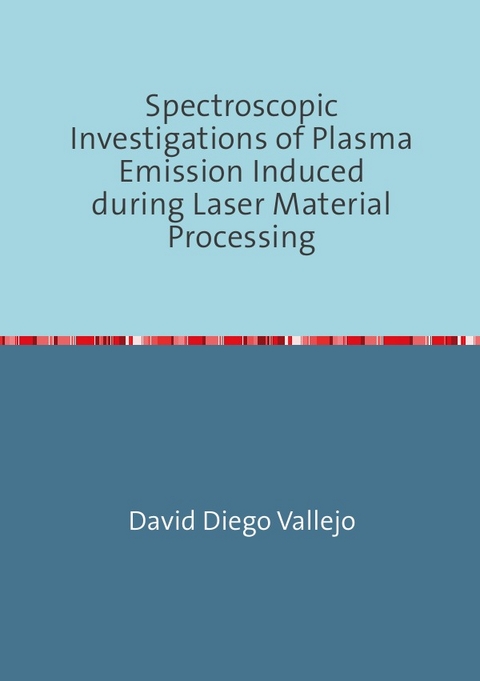
Spectroscopic Investigations of Plasma Emission Induced during Laser Material Processing
Seiten
2014
epubli (Verlag)
978-3-8442-7880-4 (ISBN)
epubli (Verlag)
978-3-8442-7880-4 (ISBN)
- Titel leider nicht mehr lieferbar
- Artikel merken
This thesis describes the use of LIBS as a monitoring technique of laser processing
The objective of this thesis was to study the feasibility of using spectroscopic analysis of plasma emission as a strategy for laser processing monitoring. To this end, the radiation emitted by the plasma induced during machining was acquired and analyzed. The influence of acquisition conditions and processing parameters on the qualitative characteristics of emission spectra was investigated. Experiments revealed that while acquisition parameters greatly affected the reproducibility and the Signal-to-Background Ratio (SBR) of spectra, variations of processing parameters presented just a small influence on the characteristics of acquired spectra.
Furthermore, three monitoring applications were studied: sample classification during processing, supervision of focus position and inspection of selective scribing of thin-film solar cells.
The spectral signatures of the plasma emission were analyzed to identify the processed sample. Linear correlation and artificial neural networks were implemented as classification methods and their performances were evaluated for variations in acquisition and processing parameters.
The position of the focused beam was monitored during laser processing based on the intensity of the plasma emission. This technique was successfully tested for different materials such as metals, ceramics and technical glasses.
Additionally, a strategy for monitoring the selective scribing of solar cells was developed. Classification methods were used to detect the emission spectra corresponding to the desired processing depth based on the spectral fingerprints of the different materials of the solar cell.
Conclusively, the potential of using plasma emission analysis for monitoring of laser processing has been demonstrated in this thesis.
The objective of this thesis was to study the feasibility of using spectroscopic analysis of plasma emission as a strategy for laser processing monitoring. To this end, the radiation emitted by the plasma induced during machining was acquired and analyzed. The influence of acquisition conditions and processing parameters on the qualitative characteristics of emission spectra was investigated. Experiments revealed that while acquisition parameters greatly affected the reproducibility and the Signal-to-Background Ratio (SBR) of spectra, variations of processing parameters presented just a small influence on the characteristics of acquired spectra.
Furthermore, three monitoring applications were studied: sample classification during processing, supervision of focus position and inspection of selective scribing of thin-film solar cells.
The spectral signatures of the plasma emission were analyzed to identify the processed sample. Linear correlation and artificial neural networks were implemented as classification methods and their performances were evaluated for variations in acquisition and processing parameters.
The position of the focused beam was monitored during laser processing based on the intensity of the plasma emission. This technique was successfully tested for different materials such as metals, ceramics and technical glasses.
Additionally, a strategy for monitoring the selective scribing of solar cells was developed. Classification methods were used to detect the emission spectra corresponding to the desired processing depth based on the spectral fingerprints of the different materials of the solar cell.
Conclusively, the potential of using plasma emission analysis for monitoring of laser processing has been demonstrated in this thesis.
David Diego Vallejo received his Bachelor's Degree in Mechatronics and his Master’s Degree in Electronics from the Instituto Politécnico Nacional, Mexico and his PhD in Engineering from the Technische Universität Berlin, Germany. He has experience in the design of laser-based engraving systems and in the development of monitoring strategies based on laser-induced fluorescence (LIF) and laser-induced breakdown spectroscopy (LIBS). His main interests are related to research and development focused on the implementation of laser technologies for processing and monitoring applications, analytical chemistry or integration of optomechatronics solutions.
| Erscheint lt. Verlag | 15.1.2014 |
|---|---|
| Sprache | englisch |
| Maße | 148 x 210 mm |
| Gewicht | 224 g |
| Themenwelt | Sachbuch/Ratgeber ► Natur / Technik ► Technik |
| Technik | |
| Schlagworte | Chemometrics • Laser Applications • laser-induced breakdown spectroscopy • Laser processing • Monitoring |
| ISBN-10 | 3-8442-7880-X / 384427880X |
| ISBN-13 | 978-3-8442-7880-4 / 9783844278804 |
| Zustand | Neuware |
| Informationen gemäß Produktsicherheitsverordnung (GPSR) | |
| Haben Sie eine Frage zum Produkt? |
Mehr entdecken
aus dem Bereich
aus dem Bereich
die wichtigsten Begriffe, Bautypen und Bauelemente
Buch | Softcover (2024)
Prestel (Verlag)
CHF 44,75
Buch | Hardcover (2021)
C. Bertelsmann (Verlag)
CHF 25,20
vom Kolosseum über die Akropolis bis zur Alhambra
Buch | Hardcover (2023)
DK (Verlag)
CHF 29,90


